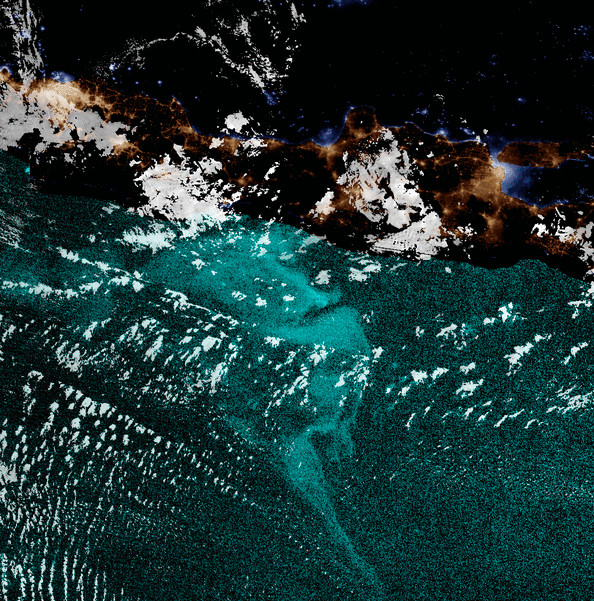Glowing 'Milky Seas' Have Baffled Sailors for Centuries—New Research Brings Scientists One Step Closer to Solving the Mystery
Glowing ‘Milky Seas’ Have Baffled Sailors for Centuries—New Research Brings Scientists One Step Closer to Solving the Mystery
Historical accounts of vast ocean waters glowing in the dark go back hundreds of years, and researchers are still trying to determine exactly what triggers the phenomenon
Glowing "milky seas," seen here from satellites, have confused and captivated sailors for centuries.
Colorado State University, CIRA and NOAA
From the deck of the American clipper ship Shooting Star, sailors watched a mysterious and unsettling scene. Describing the incident in 1854, off the coast of Java, Indonesia, the captain wrote: “The whole appearance of the ocean was like a plain covered with snow. There was scarce a cloud in the heavens, yet the sky… appeared as black as if a storm was raging. The scene was one of awful grandeur—the sea having turned to phosphorus, and the heavens being hung in blackness, and the stars going out, seemed to indicate that all nature was preparing for that last grand conflagration, which we are taught to believe is to annihilate this material world.”
This dramatic testimony is just one of many witness accounts documenting a rare, bioluminescent display aptly dubbed “milky seas.” The nighttime phenomenon, which makes vast stretches of ocean glow bright green or blue for up to months at a time, has confused sailors for centuries.
Researchers have a tentative explanation for the event: “We strongly suspect—based on the characteristics of the light and how long it lasts—that it is bacteria,” Justin Hudson, an atmospheric scientist at Colorado State University, says in a statement. But that doesn’t clarify much. “It’s a question of, how do you take some of the smallest organisms on Earth and have them engage in some behavior that’s half the size of the state of Colorado?”
Milky seas are currently unpredictable, making them all the more difficult to study. In fact, scientists are aware of only one photograph of the glow from sea level, captured in 2019. Now, however, researchers have taken a crucial step in solving the milky seas mystery.
Hudson and his colleague Steven Miller, also a Colorado State University atmospheric scientist, have compiled records of milky seas sightings from the last 400 years into a database. By assembling eyewitness reports, testimonies submitted to the Marine Observer journal and satellite data, the pair of researchers identified 415 occurrences of the strange phenomenon throughout history. They hope the database will help scientists learn to predict the rare phenomenon in order to better study it.
Not all testimonies come from scientists, and individuals without science backgrounds “capture the information completely differently,” Abigail McQuatters-Gollop, a plankton ecologist at University of Plymouth in England who wasn’t involved in the study, tells National Geographic’s Melissa Hobson. “They never thought it would be used for any ecological study.” Nonetheless, “I think they [Hudson and Miller] did the best job they could do with the kind of data they had available.”
Milky seas captured in 2019—it's the only photograph of the phenomenon from sea level known to scientists.
Steven D. Miller, PNAS 2022
As detailed last week in the journal Earth and Space Science, the compiled data revealed that most milky seas sightings take place in the Arabian Sea in the northwest Indian Ocean, as well as south of Java and in Indonesia’s Banda Sea. It also links the event to two large weather patterns: the Indian Ocean Dipole and the El Niño Southern Oscillation.
In 1985, a research vessel was able to collect a water sample during a milky seas event, which revealed the presence of a luminous kind of bacteria called Vibrio harveyi. This offers “potential proof” that milky seas are caused by a biological process linked to the bacteria, per the study.
Accordingly, the regions where milky seas are most commonly spotted experience upwelling, when strong winds churn cold, nutrient-rich water toward the surface of the ocean. “They are spots that are primed for lots of biological activity to happen,” Hudson tells CNN’s Taylor Nicioli. Upwelling can also take place during the Indian Ocean Dipole.
“But there’s lots of places on Earth that are like that,” adds Hudson to CNN. “So, what actually makes (these regions) special is a huge, open question.”
Another huge, open question that remains is how milky seas fit into their ecosystems. For example, are the glowing patches of water a symptom of a healthy or distressed marine habitat? Ultimately, the new database “allows us to begin answering questions about milky seas beyond hoping and praying a ship runs into one accidentally,” Hudson says in a statement.
Get the latest stories in your inbox every weekday.


